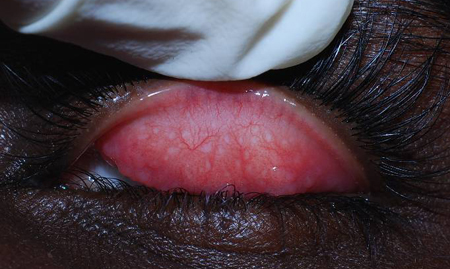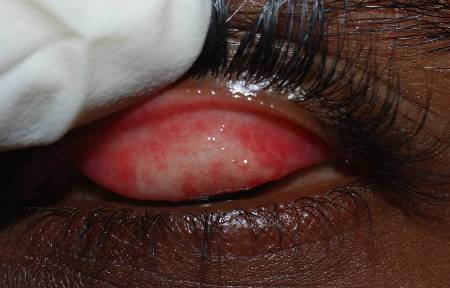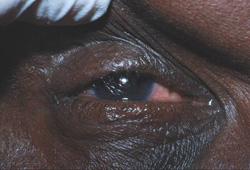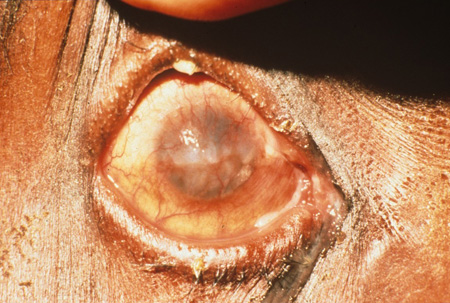Criteria
The Simplified WHO Grading Scheme[30]
This is a grading scheme that creates arbitrary definitions of active and cicatricial disease. It is useful in a practical sense because of its simplicity; however, it is not necessarily useful in diagnosing an individual and has limitations when used in research. It must be remembered that this system was designed for use in fieldwork by health workers.
Trachomatous inflammation, follicular (TF): 5 or more follicles greater than 0.5 mm on the upper tarsal conjunctiva. [Figure caption and citation for the preceding image starts]: Eyelid eversion demonstrating follicles on the upper tarsal conjunctivaFrom the collection of Dr Hugh R. Taylor [Citation ends].

Trachomatous inflammation, intense (TI): papillary hypertrophy and inflammatory thickening of the upper tarsal conjunctiva obscuring more than half of the deep tarsal vessels. [Figure caption and citation for the preceding image starts]: Eyelid eversion demonstrating intense inflammation of the upper tarsal conjunctivaFrom the collection of Dr Hugh R. Taylor [Citation ends].

Trachomatous conjunctival scarring (TS): the presence of scarring on the tarsal conjunctiva. [Figure caption and citation for the preceding image starts]: Eyelid eversion demonstrating scars on the tarsal conjunctivaFrom the collection of Dr Hugh R. Taylor [Citation ends].

Trachomatous trichiasis (TT): at least one eyelash from the upper eyelid touching the globe, or evidence of recent epilation of inturned eyelashes from the upper eyelid. [Figure caption and citation for the preceding image starts]: A red eye due to at least 1 inturned eyelash touching the globe (trachomatous trichiasis)From the collection of Dr Hugh R. Taylor [Citation ends].

Corneal opacity (CO): corneal opacity blurring part of the pupil margin. [Figure caption and citation for the preceding image starts]: Corneal opacity due to trachomaFrom the collection of Dr Hugh R. Taylor [Citation ends].

WHO Grading Scheme[30]
This is a detailed grading scheme that can only be reliably used by ophthalmologists or experienced trachoma workers. For this reason its practical use is limited. However, the system may have an important place in clinical research.
Use of this content is subject to our disclaimer